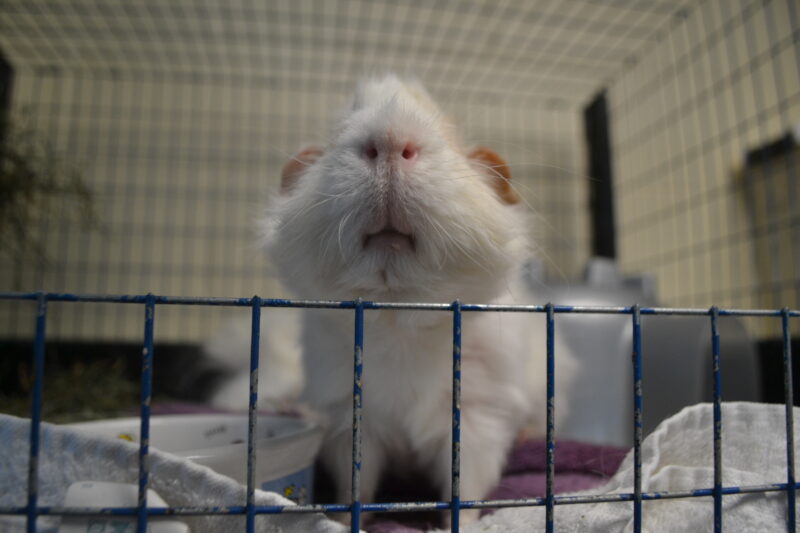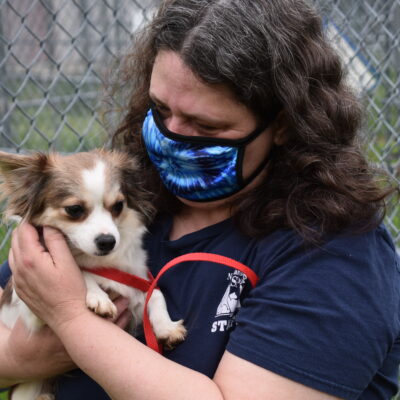
Guinea Pigs are wonderful and fun pets to have in your home. They enjoy the company of people and other guinea pigs and can also be independent and easy going. Here are some things to consider before you decide to bring a guinea pig home:
General Considerations:
- Guinea Pigs can live between 4 and 8 years. This is a longer life expectancy than other small pets such as hamsters or gerbils. It is a good idea to consider this time-frame when you adopt.
- If you will be keeping more than one guinea pig, it is always best to be sure you have all pigs of the same gender only. Typically, guinea pigs are not spayed or neutered, and they reproduce easily. So, keep only male pigs with other males and female pigs with females only.
Housing:
- Guinea Pigs need adequate space to move around and get exercise.
- How many pigs? Allocate enough space for all to be able to move about the space easily.
- Ensure that the enclosure is safe and secure, and your guinea pig cannot squeeze out from any open spaces or climb over any sides that are too short.
- Be sure to place the enclosure in an area that is temperature controlled and is free of drafts. Guinea Pigs should always be kept indoors in ambient temperatures kept between 65- and 75-degrees Fahrenheit.
- Check the internet tutorials and plans for fun and easy DIY enclosures.
- Consider the location in your home. Guinea pigs tend to be most active at night. They can move around, play with their chew toys and be noisy when drinking from their water bottle. If you are putting an enclosure in a bedroom, they may be busy and making noise while you are trying to sleep.
- Note: Guinea Pigs poop a lot. Be prepared to make regular cage cleaning part of your daily routine.
Food:
- Guinea Pigs are animals that need to eat almost constantly.
- Their digestive system must be working nearly all the time for them to stay healthy.
- Guinea Pigs cannot make their own Vitamin C. Their diet needs to be supplemented with an appropriate amount of Vitamin C to ensure their good health. Pellets are often fortified with Vitamin C. Vitamin C supplement treats come in a variety of flavors and textures. Be sure to follow the feeding instructions on the bag and consult your veterinarian with questions regarding proper feeding amounts.
Hay – Fresh hay should be supplied daily as this is what the guinea pig will munch on most of the time. Consider how many guinea pigs you have to ensure that there is adequate daily supply for them to eat
Pellets – Follow the instructions on the bag to determine the appropriate amount of pellets to feed daily. Be careful not to overfeed as your piggy may become overweight and this is not good for their health.
Fresh Vegetables and Fruit – leafy greens like romaine lettuce, baby kale, cilantro, parsley can be fed daily. Red or green pepper can also be a nice daily treat as they have high levels of vitamin C in them. Carrots, zucchini and spinach can be fed a couple of times a week. Be careful not to overfeed certain vegetables, like carrots or spinach that may be high in sugars or natural minerals.
Fruit can be given as an occasional treat. It is high in natural sugar, so it is important to keep portion sizes small. Orange or apple, a few blueberries or a small slice of banana is a great treat that most guinea pigs will love.
Introduce new foods very gradually to avoid digestive upset. If your guinea pig develops any sign of loose stool, reduce the amount of fresh vegetables and fruit for several days, until digestion returns to normal. Then try reintroducing the food in smaller portions.
Water – Ensure that your guinea pig always has ample supply of fresh water.
If they are using a bottle with a spout, rinse and clean the bottle daily. Guinea pigs will drink from the bottle with food in their mouths, sending particles of food up into the water bottle. Regular cleanings and fresh water is critical for the health of your pig. For a deep clean, you can use diluted white vinegar and let it soak in the bottle for 30 min. Use a clean bottle brush if you have one. Carefully and thoroughly rinse the bottle and spout and refill with fresh clean water.
Water Bottle Cleaning Trick – If you don’t have a bottle brush, and the inside of the bottle is looking gunky or slimy, fill partway with crushed ice and then add a little diluted white vinegar. Close the bottle and shake vigorously. The crushed ice will scrape the inside of the bottle and help to remove any slime or debris buildup. Rinse thoroughly with fresh water.
Supplies:
- Your guinea pig will need some fun things to do to keep them entertained safely.
- Find lots of safe toys at pet supply stores. Always ensure they are meant for guinea pigs and don’t contain any toxic ingredients or hazardous materials that could be dangerous for the pig to chew on or ingest.
- Guinea Pig’s teeth that grow constantly. They need to chew a lot to keep their teeth in proper condition. If their teeth grow too long or crooked, it can impact their health and their ability to properly ingest food.
- Safe guinea pig chewable toys include wood, apple sticks and some fibers. Be sure to only give your guinea pig items that are safe. Sticking with items from pet supply stores is the best way to ensure your pig’s safety.
Here is a basic list of supplies that most guinea pigs will need:
Enclosure – safe and secure and big enough for them to move around and get exercise
Water Bottle or bowl – most guinea pigs will drink out of a water bottle with spout.
Hay feeder – Some guinea pigs enjoy pulling the hay out of the hay feeder and it can help to keep the hay sanitary. Some guinea pigs will pull all the hay out and it will just end up on the floor of the enclosure.
Food Bowl – Check that it is shallow enough for your guinea pig to dip their face into
Igloo or Hidey Hut – Make sure it is big enough for your pig to turn around in. If you are adopting a young pig, they may grow, and you may end up needing a bigger hidey hut.
Enrichment/Chew Toys – apple sticks, woven fiber, wooden chew toys are all great options
Grooming – Small guinea pig nail trimmers, guinea pig shampoo for occasional bathing, brush
*Note – if you are adopting a long-haired guinea pig, consult your veterinarian regarding grooming needs as some long-haired varieties need regular bathing, brushing and grooming to stay healthy.
Bedding:
- Guinea Pigs poop a lot.
- Paper bedding can be a great option and is generally safe and easy to clean.
- Some owners prefer blanket style bedding that is regularly changed and laundered.
- Do not use wood shavings of any kind as these can emit odors and dust that can be harmful for your guinea pig’s respiratory system.
Some notes about bedding –
Determine what you can accommodate your routine to. If you have a large household with a lot of family members and frequent loads of laundry, you may find it difficult to keep up with regular laundering of guinea pig bedding. Where you live is something to consider. Before laundering, soiled blankets will need to be shaken out to remove poop and hay as you don’t want that going through the washing machine. If you live in an apartment or condo, this may not be practical and paper bedding may be easier as it can easily be dumped into a trash bag. Paper bedding can an easy solution, but it can also be costly, so if you are able to fit regular laundering of bedding into your routine, that might be the right option.
For soft blanket style bedding, you can line the bottom of the enclosure with a few layers of absorbent bath towels or similar material. The top layer should be something moisture wicking. Microfiber blankets work great for this. After a couple of washings, basic microfiber blankets can wick moisture away from the surface and down to the absorbent layers below.
Note: Many scented laundry detergents and/or fabric softeners can be irritants to guinea pig’s skin and respiratory system.
No matter what bedding you choose, be sure to clean your pet’s enclosure regularly. This will probably have to be done daily, especially if you have more than one pig. If you have one pig, you may be able to do it every other day. Always check the cage daily and remove any old uneaten fresh vegetables.
Grooming:
- It is best to consult a veterinarian regarding grooming and cleaning for your pig.
- Some long-haired pigs require consistent and regular grooming, brushing and bathing.
- Some short haired varieties don’t require a lot of grooming care.
- There are several systems and functions that help a guinea pig keep itself healthy through self-grooming.
- It is most important to keep nails trimmed regularly. Overgrown nails can lead to discomfort and health problems. Letting the nails grow too long may make it difficult to trim the nails safely to get them to a proper length.
- Check out some YouTube videos of owners trimming their pig’s nails to get a good idea of the best way to do it safely.
- Make sure you check your pig’s nails weekly to determine when it is time for a trim.
Fun and Funny Facts:
- Guinea Pigs engage in a behavior known as Coprophagia. This means that they consume their own feces. This is totally normal. Many animals do this. Since plant matter is not completely broken down the first time around, guinea pigs ingest caecals (a type of stool) to get as many nutrients as possible. This is somewhat similar to how cows chew their cud. Caecals contain essential vitamins, such as vitamin K and B-complex.
- Guinea Pigs rarely sleep. They are awake most of the time and take very short naps. Sometimes they sleep with their eyes open! Pigs are most active at night.
- Guinea Pigs are born fully furred with eyes open and moving around. They are a prey animal, so as soon as they are born, they are capable of running away from predators!
- They may all sorts of fun and silly noises. Sometimes to communicate that they are hungry or excited to get a treat. Sometimes they chutter or make a clicking noise when they are unhappy or stressed.
- Some guinea pigs enjoy being cuddled or snuggled. Others prefer to be left alone. Since they are prey animals, they naturally try to avoid being picked up. Regular quiet contact and slow approaches with patting and gentle picking up over time will get them used to their owner and help them realize that they are safe. Still, some piggies will prefer to be left alone and that is ok. It is often a good idea to adopt in pairs or groups (as long as they are all the same gender) as they can be social animals with one another.


